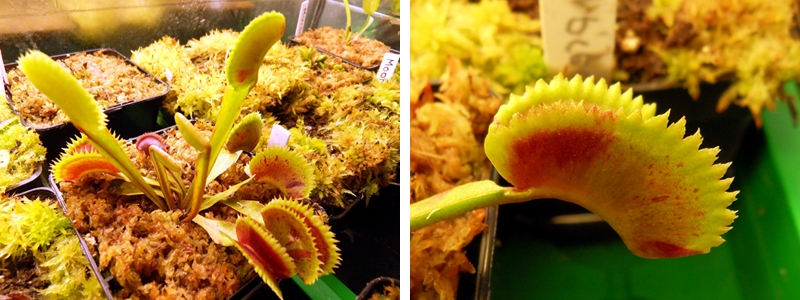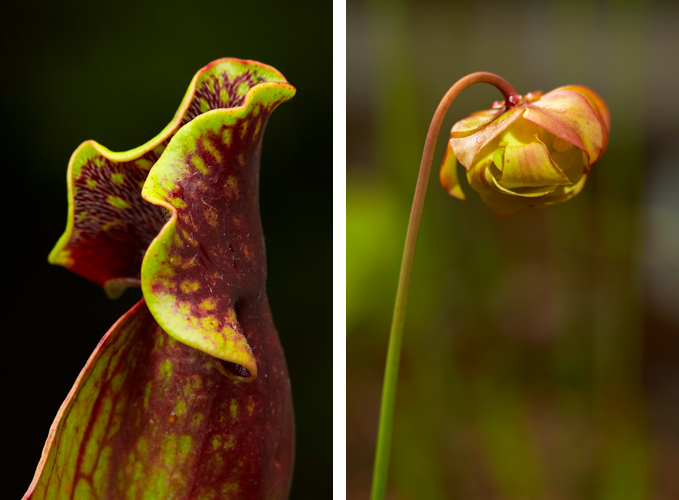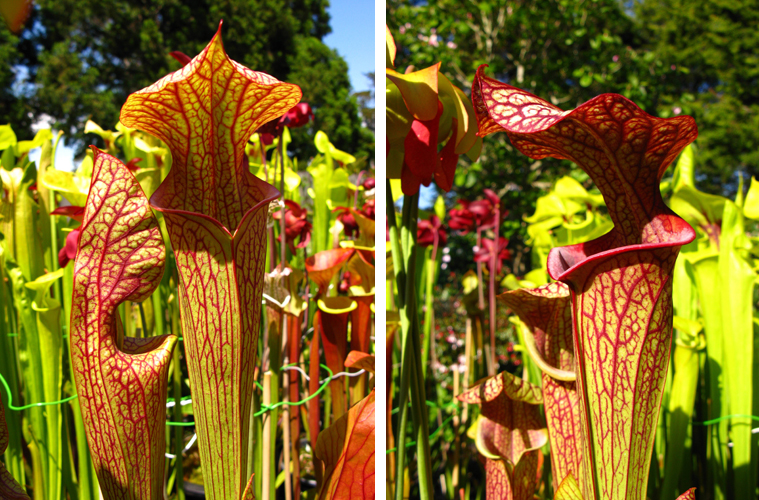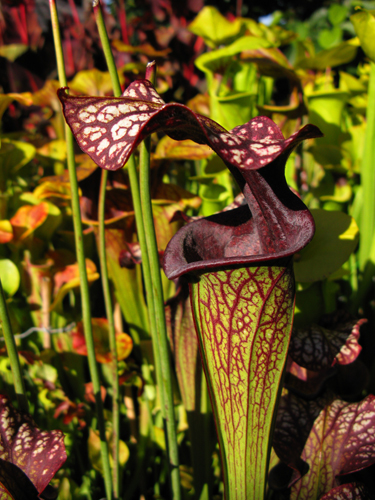|
Carnivorous Plant Newsletter
Volume 41, Number 1, March 2012, pages 27 - 30
New Cultivars
Dionaea ‘Scarlatine’ (English: D. ‘Scarlet Fever’)
Sarracenia purpurea ‘Phoenix’
Sarracenia ‘Zjahnine’
Dionaea ‘Scarlatine’ (English: D. ‘Scarlet Fever’)
Submitted: 28 September 2011
The parentage of Dionaea ‘Scarlatine’ is D. ‘Dentate Traps’ × D. ‘Royal Red’. This Dionaea
muscipula cultivar may be reproduced vegetatively by rhizome or leaf cuttings in order to preserve
the characteristics of the mother plant, as follows:
Trap margin with short irregular dentition of a dentate sawtooth type, having a yellow-green
color displaying red sprinkles or spots (see Fig. 1). The petiole with the same background coloration
as the trap likewise shows red sputtering.
Dionaea ‘Scarlatine’ was bred in April 2008 and named in April 2011 by the author. The epithet
refers to the spots visible on the plant that resemble the rash caused by the childhood disease scarlet
fever.
—Lucien Blacher • Beynost • France • blaluc48@hotmail.fr

Figure 1: Dionaea ‘Scarlatine’ plant and trap. Photo by Lucien Blacher.
Sarracenia purpurea ‘Phoenix’
Submitted: 29 October 2011
Sarracenia purpurea ‘Phoenix’ has a rather interesting history. In the early 1990s, Jim Bockowski and I frequently took trips to the area locally called the New Jersey Pine Barrens or Pinelands. On one of these trips, we stopped by one of his favorite spots near an old railroad bed that had a great diversity of carnivorous plants including several species of Utricularia and Drosera and many S. purpurea. One of these plants stood out.
The young plant grew on the south side of the railroad bed partly submerged in water and baking in full sun. The colors of this plant were striking: dark maroon/red throughout but the hood margin was lime green (see Fig. 2). Several years later I was treated with an additional bonus – the plant’s flowers were orange/yellow – which made the plant even more unique (see Fig. 2).
In the late 1990s, the plant was transferred to Jim Bockowski’s care. He verified the orange flower colors (he thought I was crazy when I first mentioned it to him) and produced seed through self-fertilization. Shortly thereafter, the parent plant perished due to a fungus attack. Offspring of this plant that exhibit the diagnostic characteristics are called S. purpurea ‘Phoenix’ referring to a mythical bird with a colorful plumage and a tail of gold and scarlet (or purple, blue, and green according to some legends) and which has an ability to be reborn from its own ashes. The registrant believes the name fits with the plant’s history and dark maroon/red leaf color and orange/yellow flowers.
—Christoph Belanger • Sleepy Hollow, NY 10591 • USA • christoph_belanger2001@yahoo.com

Figure 2: Pitcher and flower of Sarracenia purpurea ‘Phoenix’. Photo by Christoph Belanger.
Sarracenia ‘Zjahnine’
Submitted: 16 December 2011
This exceptional Sarracenia hybrid is the result of the pollination of Sarracenia oreophila by Sarracenia leucophylla. The pollination was conducted by fellow New Zealand grower, Don Gray, in 2003. The seed was subsequently germinated by me in 2004 and from the resultant seedlings I selected this clone in 2008 for its distinctive properties.
Following the growth pattern of the S. oreophila parent, only one flush of pitchers is produced early in the spring following flowering. In form the pitchers are a blend of both the S. oreophila and S. leucophylla parents being upright with a large undulate hood, a notable spout, and attain a height of 70 cm. Ensiform non-carnivorous leaves intermediate between those of the parents are produced midsummer and endure throughout the winter. Flowers are simple yellow with pink petals.
The noteworthy characteristic of this hybrid is its extreme vivid coloration which evolves rapidly once each pitcher opens. Initially the pitchers are pleasant yellowish green with intricate red venation over the upper third of the leaf (see Fig. 3). Some white areolae are discernible on the hood within its vein network. Within three days red begins to suffuse within the nectar roll, the interior of the mouth, and the interior and exterior of the hood (see Fig. 4). Over the course of the next month this red suffusion becomes more intensive, darkening notably, and white areolae become more apparent on the exterior of the hood (see Fig. 5). By the end of the second month the pitcher’s venation, the nectar roll, and the interior of the pitcher have become a very dark purple (see Back Cover). At this stage the white areolae present on the hood have become entirely visible against the dark suffused background (see Fig. 6). Throughout the attainment of this ultimate coloration the veins of the pitcher tube itself remain distinct against the yellowish green of the tube, the exterior of the column, and mid-line of the rear of the hood. A very limited number of small areolae may be found on the tube exterior below the mouth on some pitchers. The lower two-thirds of the pitcher remain yellowish green almost devoid of veining. These features are established at a point mid growth season and well before pitcher desiccation at the onset of dormancy. The photos are of a specimen grown permanently outdoors.
The name ‘Zjahnine’ is a phonetic re-spelling of the person’s name, Janine, and is in honor of a valued friend.
Vegetative propagation is necessary to maintain the unique features of this hybrid.
—Julian Brook • Auckland • New Zealand • hold_the_bus@yahoo.co.nz

Figure 3: Sarracenia ‘Zjahnine’ opening
pitcher. Photos by Julian Brook. |
Figure 4: Sarracenia ‘Zjahnine’ pitcher
three days after opening. |

Figure 5: Sarracenia ‘Zjahnine’ pitcher
one month after opening. |
Figure 6: Sarracenia ‘Zjahnine’ mature
pitcher lid. |

Back Cover: Sarracenia ‘Zjahnine’. Photo by Julian Brook.
|

